Kiel legi la taksonomion | ||||||||||||||
|---|---|---|---|---|---|---|---|---|---|---|---|---|---|---|
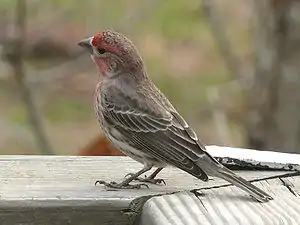 maskla plenkreskulo
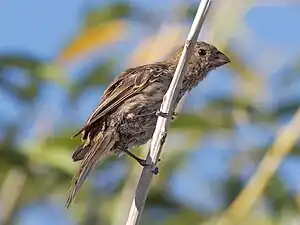 ina plenkreskulo | ||||||||||||||
| Biologia klasado | ||||||||||||||
| ||||||||||||||
| Carpodacus mexicanus (Müller, 1776) | ||||||||||||||
| Konserva statuso | ||||||||||||||
Aliaj Vikimediaj projektoj | ||||||||||||||
La Ruĝkapa karpodako (Carpodacus mexicanus) estas birdo de la familio de Fringedoj. Tiu specio kaj la aliaj "amerikaj karpodakoj" estas kutime lokataj en la genro Carpodacus, sed ili ŝajne apartenus al distinga genro Burrica. Karpodakoj estas birdoj brunecaj, kun ruĝaj aŭ rozkoloraj ĝeneraaj nuancoj aŭ markoj en kapo, brusto, pugo ktp.
Oni proponis lokigi ilin en distingan genron Burrica, sed la American Ornithologists Union malakceptis tion en 2008.[1]
Aspekto
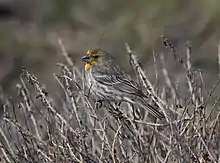

Plenkreskulo havas longan, kvadratfinan brunan voston kaj estas bruna aŭ bruneca en dorso kun iom da nuanco al griza en flugilplumoj. Brusto kaj ventro povas esti striecaj; la flankoj tiaj estas kutime. Plej ofte masklaj plenkreskuloj havas ruĝecajn kapojn, kolojn kaj ŝultrojn.[2][3] Tiu koloro foje etendas al supra ventro kaj suba dorso, inter flugiloj. Maskla koloro varias intensece laŭ sezonoj kaj dependas el beroj kaj fruktoj manĝitaj.[4][5] Kiel rezulto, la koloroj gamas el hela pajlflava tra brilorangza (ambaŭ rare) al tre intensa ruĝo. Ina plenkreskulo havas brunajn suprajn partojn kaj striecajn subajn partojn.
Ties kanto estas rapida, vigla trilado aŭ vario de ĉirpoj.[6]
Teritorio kaj vivejo
Tiuj nearktisaj birdoj estas ĉefe loĝantaj birdoj; kelkaj orientaj birdoj migras suden.[7] Ties reprodukta vivejo estas urbaj kaj ĉeurbaj areoj en Oriento same kiel variaj duonmalfermaj areoj okcidente el suda Kanado al norda Florido[5] kaj la Meksika ŝtato de Oaĥako; la populacio de centra Ĉiapaso povus deveni el eskapitaj kaĝobirdoj.[3]
Origine loĝanta nur en Meksiko kaj sudokcidenta Usono, ili estis enmetitaj en orienta Nordameriko en la 1940-aj jaroj. Tiuj birdoj estis venditaj neleĝe en Novjorko[5] kiel "Holivudaj fringoj", merkata trompinventaĵo.[4] Por eviti persekutadon laŭ la Traktato de Migrantaj Birdoj de 1918, vendistoj kaj posedantoj liberigis la birdojn. Ili naturiĝis; en kelkaj nearbaraj areoj, ili anstataŭis kaj la indigenan specion de la Purpura karpodako kaj la ne indiĝenan de la Hejmpasero.[8] En 1870, aŭ antaŭe, ili estis enmetitaj en Havajo.[9]
Simile oni enkondukis la specion en sudorienta Hispanio, nome en urbo Murcio, kun unuaj individuoj en 2015, unuaj reproduktoj en 2017 kaj ĝis 20 reproduktaj paroj en 2019.[10]
Manĝo
Ruĝkapaj karpodakoj manĝas surgrunde aŭ inter vegetaĵaro normale. Ili manĝas ĉefe grajnojn, semojn kaj berojn, kaj estas grandaj konsumantoj de herbosemoj kiaj de urtiko and taraksako; inklude estas eventuale malgrandaj insektoj kiaj afidoj. Ili estas oftaj vizitantoj de birdomanĝejoj la tutan jaron, ĉefe se ili enhavas semojn de sunfloro aŭ Guizotia abyssinica, kaj ili aregiĝas je pendantaj manĝejoj de tiu planto. Oni scias ke, la Ruĝkapa karpodako damaĝas ortofruktojn kaj konsumas komercajn kreskitajn grajnojn, sed ĝi ne estas ĝenerale konsiderata grava plago, sed pli bone nur ĝeno.[11]
Reproduktado
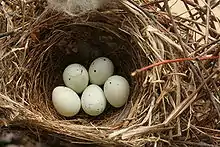
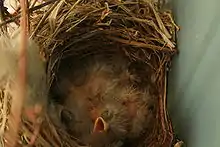
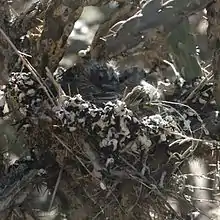
Nestoj estas farataj en kavaĵoj, inklude truojn en konstruaĵoj, pendantaj plantoj kaj aliaj tasformaj eksteraj strukturoj. Foje oni uzas nestojn abandonitajn de aliaj birdoj. Nestoj povas esti reuzataj por sekvaj ovodemetadoj aŭ en venontaj jaroj. La nesto estas konstruata de la ino, foje tiom rapide kiom eĉ dum du tagoj.[12] Ĝi estas farata el bastonetoj kaj rubaĵoj, formante kutime tasforman neston je 1.8 ak 2.7 m supergrunde.[12]
Dum pariĝado, la masklo tuŝas bekojn kun la ino. Li povas tiam donaci al la ino manĝerojn kaj, se ŝi imitas la sintenon de malsata ido, fakte manĝigi ŝin. La masklo manĝigas la inon ankaŭ dum la reproduktado kaj kovado kaj de ovoj kaj de idoj.[13]
La ino ovodemetas el februaro al aŭgusto, dum du aŭ pliaj ovodemetadoj jare po 2 al 6 ovoj ĉiun ovaron, plej komune 4 aŭ 5. Ovodemetado okazas ĉefe matene, po unu ovon ĉiutage.[13] La ovoj estas palbluecverdaj kun kelkaj nigraj punktoj kaj iom brila surfaco. Kiel reago al akarinfestado, la fringino povas fari unue unuan ovodemetadon, kio pliigas la eblon survivi de la fingridoj.[14] La ino kovas la ovojn dum 12 al 14 tagoj. Iom post eloviĝo, la ino forigas la malplenajn ovoŝelojn el la nesto.[15][16] La idoj estas rozkoloraj kun fermitaj okuloj kaj tufoj de lanugo.[17] La ino ĉiam manĝigas la idojn, kaj la masklo kutime aliĝas.[13] La junuloj estas silentemaj dum la unuaj 7 aŭ 8 tagoj kaj sekve ekpepas dum manĝado.[12] Dekomence la patrino elportas la fekosakojn for de la nesto, sed kiam la junuloj pluaĝas, jam ne faras tion kaj permesas ke la fekaĵoj akumulas ĉirkaŭ la bordo de la nesto.[12] Antaŭ elnestiĝo, la junuloj ofte grimpas al apudaj plantoj, kaj kutime ekflugas ĉirkaŭ post 11 al 19 tagoj post eloviĝo.[12] Semoj de leontodo estas inter la plej preferataj por manĝigi la idojn.[15]
Ruĝkapaj karpodakoj estas sufiĉe agresemaj por forpeli aliajn birdojn for de lokoj kiaj manĝejoj.[18]
Parazitoj
La Ruĝkapa karpodako povas esti infektata de granda vario de parazitoj inklude Plasmodium relictum[19] kaj Mycoplasma gallisepticum, kiu kaŭzis la falon de la populacio de Ruĝkapa karpodako en orienta Nordameriko ĝis preskaŭ formorto dum la 1990-aj jaroj.[20]
La akaro Pellonyssus reedi troviĝas ofte en la idoj de Ruĝkapa karpodako, precipe en nestoj plej malfruaj en la sezono.[21]
La Brunkapa molotro, nestoparazito, demetas siajn ovojn en nestoj de Ruĝkapa karpodako, kvankam la dieto per kiuj la Ruĝkapa karpodako manĝigas siajn idojn estas netaŭga por la junaj molotroj, kiuj rare survivas.[22]
Referencoj
- ↑ (2008) “[http://www.aou.org/checklist/suppl/AOU_checklist_suppl_49.pdf Forty-ninth Supplement to the American Ornithologists’ Union Check-list of North Americancancan Birds]”, The Auk (PDF) 125 (3), p. 11.
- ↑ Sibley, David. (2000) The Sibley Guide to Birds. Knopf. ISBN 0679451226.
- 1 2 Steve N. G. Howell and Sophie Webb. (1995) A Guide to the Birds of Mexico and Northern Central America. Oxford University Press, p. 757–758. ISBN 0198540124.
- 1 2 Caldwell, Eldon R. IV Birds - House Finch. Arkivita el la originalo je 2007-09-29. Alirita 2008-04-19. Arkivita kopio. Arkivita el la originalo je 2007-09-29. Alirita 2010-09-21.
- 1 2 3 All About Birds: House Finch. Cornell Laboratory of Ornithology. Alirita 2008-04-19.
- ↑ House finch Carpodacus mexicanus. Arkivita el la originalo je 2011-05-15. Alirita 2010-09-21.
- ↑ (1991) “Partial Migration and Differential Winter Distribution of House Finches in the Eastern United States”, The Condor (PDF) 93 (2), p. 374. doi:10.2307/1368953. Arkivigite je 2010-08-08 per la retarkivo Wayback Machine Arkivita kopio. Arkivita el la originalo je 2010-08-08. Alirita 2010-09-21.
- ↑ Wootton, JT. date = 1987 (1987). “Interspecific Competition between Introduced House Finch Populations and Two Associated Passerine Species”, Oecologia 71 (3), p. 325–331. doi:10.1007/BF00378703.
- ↑ (1933) “The exotic birds of Hawaii”, Bishop Museum Occasional Papers 10 (9).
- ↑ "Aves de España", Aves y naturaleza, Madrido, nº 31, 2020, paĝo 17. Citita el A. Guardiola kaj L. Martínez-Mena. Quercus, 408: 24-27.
- ↑ Montana state government House finch detailed information. Arkivita el la originalo je 2009-12-20. Alirita 2007-08-14. Arkivita kopio. Arkivita el la originalo je 2009-12-20. Alirita 2010-09-21.
- 1 2 3 4 5 (1957) “Observations on Nesting Behavior of the House Finch”, The Condor (PDF) 59 (2). Alirita 2008-06-28.. Arkivigite je 2011-06-06 per la retarkivo Wayback Machine Arkivita kopio. Arkivita el la originalo je 2011-06-06. Alirita 2010-09-21.
- 1 2 3 (1960) “Agonistic Behavior in the House Finch. Part I: Annual Cycle and Display Patterns”, The Condor (PDF) 62 (4), p. 245. doi:10.2307/1365516. Alirita 2008-06-28.. Arkivigite je 2011-06-06 per la retarkivo Wayback Machine Arkivita kopio. Arkivita el la originalo je 2011-06-06. Alirita 2010-09-21.
- ↑ (September 26, 2006) “Sex-biased maternal effects reduce ectoparasite-induced mortality in a passerine bird”, Proceedings of the National Academy of Sciences of the United States of America 103 (39), p. 14406. doi:10.1073/pnas.0602452103. Alirita 2008-07-25..
- 1 2 Bergtold, W.H. (1913) A Study of the House Finch (PDF). The Auk. Arkivita el la originalo je 2011-06-06. Alirita 2008-05-23. Arkivita kopio. Arkivita el la originalo je 2011-06-06. Alirita 2010-09-21.
- ↑ Woods, Robert S. (1968). “Life Histories of Familiar North American Birds: House Finch”, Smithsonian Institution United States National Museum Bulletin (237), p. 290–314.
- ↑ "House Finch Nest Survey" (PDF). Alirita 2008-06-28.
- ↑ Backyard Birds of Winter in Nova Scotia. Museum.gov.ns.ca. Alirita 2009-08-18. Arkivita kopio. Arkivita el la originalo je 2010-10-14. Alirita 2010-09-21.
- ↑ Hartup, Oberc, Stott-Messick, Davis, kaj Swarthout, Barry K., Allison, Briana, and Elliott C.H. (aprilo 2008). “Blood Parasites of House Finches (Carpodacus mexicanus) from Georgia and New York”, Journal of Wildlife Diseases 44 (2).
- ↑ (7 June 1998) “Sex, Size, and Plumage Redness Predict House Finch Survival in an Epidemic”, Proceedings: Biological Sciences (PDF) 265 (1400).
- ↑ (2000) “Nest mites (Pellonyssus reedi) and the reproductive biology of the house finch (Carpodacus mexicanus)”, The Canadian Journal of Zoology (PDF) 78, p. 2126. doi:10.1139/cjz-78-12-2126.
- ↑ (1996) “Unsuitability of the House Finch as a Host of the Brown-Headed Cowbird”, The Condor (PDF) 96 (2). Arkivigite je 2012-05-27 per la retarkivo Wayback Machine Arkivita kopio. Arkivita el la originalo je 2012-05-27. Alirita 2010-09-21.
Literaturo
Libro
- Hill, G. E. 1993. House Finch (Carpodacus mexicanus). In The Birds of North America, No. 46 (A. Poole and F. Gill, Eds.). Philadelphia: The Academy of Natural Sciences; Washington, D.C.: The American Ornithologists’ Union.
Tezoj
- Avery ML. (1983). DEVELOPMENT AND TRANSMISSION OF METHIOCARB-INDUCED FOOD AVERSIONS IN CAPTIVE HOUSE FINCHES (CARPODACUS MEXICANUS). University of California, Davis, United States, California.
- Badyaev AV. (1998). Evolution of sexual dimorphism in birds: Ecological patterns, current selection, and ontogenetic variation. University of Montana, United States, Montana.
- Belthoff JR. (1992). Ecological and hormonal correlates of social dominance in house finches. Clemson University, United States, South Carolina.
- Farmer KL. (2006). Study of a novel host-parasite relationship: Mycoplasma gallisepticum in house finches (Carpodacus mexicanus). Auburn University, United States, Alabama.
- Gaudette MT. (1998). Modeling wetland songbird community integrity in central Pennsylvania. The Pennsylvania State University, United States, Pennsylvania.
- Hamilton TR. (1991). The expansion of the eastern house finch population and its impact on populations of house sparrows, purple finches and American goldfinches. Ball State University, United States, Indiana.
- Hawley DM. (2005). Host heterogeneity and disease resistance in house finches (Carpodacus mexicanus): Integrating genetics, immunity, and social behavior. Cornell University, United States, New York.
- Hess CM. (2005). The evolution of the major histocompatibility complex in house finches (Carpodacus mexicanus). University of Washington, United States, Washington.
- Hill GE. (1991). The evolution of colorful plumage in the house finch. University of Michigan, United States, Michigan.
- Kelly TD. (1991). Impact of agroforestry plantations grown with agricultural drainwater on avian abundance and diversity in the San Joaquin Valley, California. California State University, Fresno, United States, California.
- Kozlovic DR. (1997). Consequences of brood parasitism by cowbirds on house finches in a new area of sympatry. University of Toronto (Canada), Canada.
- Navara KJ. (2005). Yolk androgen deposition in two passerine species: Do females play favorites?. Auburn University, United States, Alabama.
- Randell SM. (1996). A study of avian populations and behavior at a proposed wind energy production facility near Fort Davis, Texas. Sul Ross State University, United States, Texas.
- Thakur S. (1999). Effect of high temperatures and crowding on leukocyte and parasite counts of the house finch (Carpodacus mexicanus). California State University, Fullerton, United States, California.
- Tobin ME. (1983). CONDITIONED AVERSIONS IN THREE SPECIES OF FRUIT-EATING BIRDS (FINCH, ROBIN, STARLING). University of California, Davis, United States, California.
- Vanderpool KS. (1993). A model for predicting House Sparrow and House Finch ratios in urban southern California. California State University, Fullerton, United States, California.
- Vazquez-Phillips MA. (1992). Population differentiation of the house finch (Carpodacus mexicanus) in North America and the Hawaiian Islands. University of Toronto (Canada), Canada.
- Zahn SN. (1999). Fitness correlates of different color morphs of male house finches (Carpodacus mexicanus frontalis). University of California, Santa Barbara, United States, California.
Artikoloj
- Able KP & Belthoff JR. (1998). Rapid 'evolution' of migratory behaviour in the introduced house finch of eastern North America. Proceedings of the Royal Society of London Series B Biological Sciences. p. 7, 1998.
- Aldrich JW. (1983). Rapid Evolution in the House Finch Carpodacus-Mexicanus. Journal of the Yamashina Institute for Ornithology. vol 14, no 2-3. p. 179-186.
- Aldrich JW & Weske JS. (1978). ORIGIN AND EVOLUTION OF EASTERN HOUSE FINCH POPULATION. Auk. vol 95, no 3. p. 528-536.
- Aldrich JW & Weske JS. (1978). Origin and Evolution of the Eastern House Finch Population. Auk. vol 95, no 3. p. 528-536.
- Arnaiz-Villena, A., Moscoso, J., Ruiz-del-Valle, V., Gonzalez, J., Reguera, R., Wink, M., I. Serrano-Vela, J. 2007. Bayesian phylogeny of Fringillinae birds: status of the singular African oriole finch Linurgus olivaceus and evolution and heterogeneity of the genus Carpodacus. Acta Zoologica Sinica, 53 (5):826 - 834. PDF plena teksto
- Avery ML. (1996). Food avoidance by adult house finches, Carpodacus mexicanus, affects seed preferences of offspring. Animal Behaviour. vol 51, no 6. p. 1279-1283.
- Avery ML, Schreiber CL & Decker DG. (1999). Fruit sugar preferences of House Finches. Wilson Bulletin. vol 111, no 1. p. 84-88.
- Badyaev AV, Beck ML, Hill GE & Whittingham LA. (2003). The evolution of sexual size dimorphism in the house finch. V. Maternal effects. Evolution. vol 57, no 2. p. 384-396.
- Badyaev AV, Hamstra TL, Oh KP & Seaman DAA. (2006). Sex-biased maternal effects reduce ectoparasite-induced mortality in a passerine bird. Proceedings of the National Academy of Sciences of the United States of America. vol 103, no 39. p. 14406-14411.
- Badyaev AV & Hill GE. (2000). The evolution of sexual dimorphism in the house finch. I. Population divergence in morphological covariance structure. Evolution. vol 54, no 5. p. 1784-1794.
- Badyaev AV & Hill GE. (2002). Paternal care as a conditional strategy: Distinct reproductive tactics associated with elaboration of plumage ornamentation in the house finch. Behavioral Ecology. vol 13, no 5. p. 591-597.
- Badyaev AV, Hill GE, Dunn PO & Glen JC. (2001). Plumage color as a composite trait: Developmental and functional integration of sexual ornamentation. American Naturalist. vol 158, no 3. p. 221-235.
- Badyaev AV, Hill GE, Stoehr AM, Nolan PM & McGraw KJ. (2000). The evolution of sexual size dimorphism in the house finch. II. Population divergence in relation to local selection. Evolution. vol 54, no 6. p. 2134-2144.
- Badyaev AV, Hill GE & Whittingham LA. (2001). The evolution of sexual size dimorphism in the house finch. IV. Population divergence in ontogeny. Evolution. vol 55, no 12. p. 2534-2549.
- Badyaev AV & Martin TE. (2000). Sexual dimorphism in relation to current selection in the house finch. Evolution. vol 54, no 3. p. 987-997.
- Badyaev AV, Whittingham LA & Hill GE. (2001). The evolution of sexual size dimorphism in the house finch. III. Developmental basis. Evolution. vol 55, no 1. p. 176-189.
- Bancroft J & Parsons RJ. (1991). Range Expansion of the House Finch into the Prairie Provinces. Blue Jay. vol 49, no 3. p. 128-136.
- Belthoff JR, Dufty AM, Jr. & Gauthreaŭ SA, Jr. (1994). Plumage variation, plasma steroids and social dominance in male House Finches. Condor. vol 96, no 3. p. 614-625.
- Belthoff JR & Gauthreaŭ SAJ. (1991). Partial Migration and Differential Winter Distribution of House Finches in the Eastern USA. Condor. vol 93, no 2. p. 374-382.
- Belthoff JR & Gowaty PA. (1996). Male plumage coloration affects dominance and aggression in female house finches. Bird Behavior. vol 11, no 1. p. 1-7.
- Bennett WA. (1990). Scale of Investigation and the Detection of Competition an Example from the House Sparrow and House Finch Introductions in North America. American Naturalist. vol 135, no 6. p. 725-747.
- Bitterbaum E & Baptista LF. (1979). Geographical Variation in Songs of California House Finches Carpodacus-Mexicanus. Auk. vol 96, no 3. p. 462-474.
- Bittner RA. (1995). House finch at Abernethy in 1990. Blue Jay. vol 53, no 1. p. 42-43.
- Bosakowski T. (1986). Winter Population Trends of the House Finch Carpodacus-Mexicanus and Ecologically Similar Species in Northeastern New-Jersey USA. American Birds. vol 40, no 4. p. 1105-1110.
- Calder WA, III. (1981). Diuresis on the Desert? Effects of Fruit Feeding and Nectar Feeding on the House Finch Carpodacus-Mexicanus and Other Species. Condor. vol 83, no 3. p. 267-268.
- Cook AG. (1984). Birds of the Desert Region of Uintah County Utah USA. Great Basin Naturalist. vol 44, no 4. p. 584-620.
- Dale J, Lank DB & Reeve HK. (2001). Signaling individual identity versus quality: A model and case studies with ruffs, queleas, and house finches. American Naturalist. vol 158, no 1. p. 75-86.
- Davis AK. (2005). A comparison of age, size, and health of House Finches captured with two trapping methods. Journal of Field Ornithology. vol 76, no 4. p. 339-344.
- Dawson WR, Buttemer WA & Carey C. (1985). A Reexamination of the Metabolic Response of House Finches Carpodacus-Mexicanus to Temperature. Condor. vol 87, no 3. p. 424-427.
- Dawson WR, Marsh RL, Buttemer WA & Carey C. (1983). Seasonal and Geographic Variation of Cold Resistance in House Finches Carpodacus-Mexicanus. Physiological Zoology. vol 56, no 3. p. 353-369.
- Duckworth RA, Badyaev AV & Parlow AF. (2003). Elaborately ornamented males avoid costly parental care in the house finch (Carpodacus mexicanus): A proximate perspective. Behavioral Ecology & Sociobiology. vol 55, no 2. p. 176-183.
- Duckworth RA, Mendonca MT & Hill GE. (2004). Condition-dependent sexual traits and social dominance in the house finch. Behavioral Ecology. vol 15, no 5. p. 779-784.
- Eason PK. (1998). Predation of a female House Finch, Carpodacus mexicanus, by a Gray Squirrel, Sciurus carolinensis. Canadian Field Naturalist. vol 112, no 4. p. 713-714.
- Gammon DE & Maurer BA. (2002). Evidence for non-uniform dispersal in the biological invasions of two naturalized North American bird species. Global Ecology & Biogeography. vol 11, no 2. p. 155-161.
- Giesbrecht DS & Ankney CD. (1998). Predation risk and foraging behaviour: An experimental study of birds at feeders. Canadian Field Naturalist. vol 112, no 4. p. 668-675.
- Gilbert WM, Nolan PM, Stoehr AM & Hil GE. (2005). Filial cannibalism at a House Finch nest. Wilson Bulletin. vol 117, no 4. p. 413-415.
- Graham DS. (1987). Frequent Cowbird Parasitism of House Finches Carpodacus-Mexicanus at Guelph Ontario Canada. Ontario Birds. vol 5, no 3. p. 116-117.
- Graham DS. (1988). House Finch Nest-Site Selection at Guelph Ontario Canada. Condor. vol 90, no 1. p. 58-60.
- Hill GE. (1990). Female House Finches Prefer Colorful Males Sexual Selection for a Condition-Dependent Trait. Animal Behaviour. vol 40, no 3. p. 563-572.
- Hill GE. (1992). Proximate Basis of Variation in Carotenoid Pigmentation in Male House Finches. Auk. vol 109, no 1. p. 1-12.
- Hill GE. (1993). The proximate basis of inter- and intra-population variation in female plumage coloration in the House Finch. Canadian Journal of Zoology. vol 71, no 3. p. 619-627.
- Hill GE. (1993 (1994)). Male mate choice and the evolution of female plumage coloration in the house finch. Evolution. vol 47, no 5. p. 1515-1525.
- Hill GE. (1994). Geographic variation in male ornamentation and female mate preference in the house finch: A comparative test of models of sexual selection. Behavioral Ecology. vol 5, no 1. p. 64-73.
- Hill GE. (1994). GEOGRAPHIC-VARIATION IN MALE ORNAMENTATION AND FEMALE MATE PREFERENCE IN THE HOUSE FINCH - A COMPARATIVE TEST OF MODELS OF SEXUAL SELECTION. Behavioral Ecology. vol 5, no 1. p. 64-73.
- Hill GE. (1995). Seasonal variation in circulating carotenoid pigments in the house finch. Auk. vol 112, no 4. p. 1057-1061.
- Hill GE. (1996). Subadult plumage in the house finch and tests of models for the evolution of delayed plumage maturation. Auk. vol 113, no 4. p. 858-874.
- Hill GE. (1998). Plumage redness and pigment symmetry in the House Finch. Journal of Avian Biology. vol 29, no 1. p. 86-92.
- Hill GE. (2001). Pox and plumage coloration in the House Finch: A critique of Zahn and Rothstein. Auk. vol 118, no 1. p. 256-260.
- Hill GE & McGraw KI. (2004). Correlated changes in male plumage coloration and female mate choice in cardueline finches. Animal Behaviour. vol 67, no 1. p. 27-35.
- Hill GE & Montgomerie R. (1994). Plumage colour signals nutritional condition in the house finch. Proceedings of the Royal Society of London Series B Biological Sciences. vol 258, no 1351. p. 47-52.
- Hill GE, Montgomerie R, Roeder C & Boag P. (1994). Sexual selection and cuckoldry in a monogamous songbird: Implications for sexual selection theory. Behavioral Ecology & Sociobiology. vol 35, no 3. p. 193-199.
- Hill GE, Nolan PM & Stoehr AM. (1999). Pairing success relative to male plumage redness and pigment symmetry in the house finch: Temporal and geographic constancy. Behavioral Ecology. vol 10, no 1. p. 48-53.
- Hill JR, III. (1988). The Eastern House Finch Nesting in Purple Martin Houses and Gourds. American Birds. vol 42, no 1. p. 36-38.
- Hooge PN. (1990). Maintenance of Pair-Bonds in the House Finch. Condor. vol 92, no 4. p. 1066-1067.
- Horn DJ, Abdallah M, Bastian MK, DeMartini JR & Wilhelmi RM. (2003). Bird abundance at feeders increases with decreasing distance to cover. Transactions of the Illinois State Academy of Science. vol 96, no 4. p. 247-254.
- Hosseini PR, Dobson AP & Dhondt AA. (2004). The effects of seasonal breeding and social structure on wildlife disease: the House Finch - MG system. Ecological Society of America Annual Meeting Abstracts. vol 89, no 230.
- Hughes JW & Hudson FK. (1997). Songbird nest placement in Vermont Christmas tree plantations. Canadian Field Naturalist. vol 111, no 4. p. 580-585.
- Kozlovic DR. (1998). Parasitism by Brown-headed Cowbirds and productivity of House Finch hosts. Canadian Journal of Zoology. vol 76, no 9. p. 1714-1721.
- Kozlovic DR, Knapton RW & Barlow JC. (1996). Unsuitability of the house finch as a host of the brown-headed cowbird. Condor. vol 98, no 2. p. 253-258.
- Lindstrom KM, Hawley DM, Davis AK & Wikelski M. (2005). Stress responses and disease in three wintering house finch (Carpodacus mexicanus) populations along a latitudinal gradient. General & Comparative Endocrinology. vol 143, no 3. p. 231-239.
- MacMillen RE & Hinds DS. (1998). Water economy of granivorous birds: California house finches. Condor. vol 100, no 3. p. 493-503.
- McClure HE. (1989). Occurrence of Feather Mites Proctophyllodidae among Birds of Ventura County Lowlands California USA. Journal of Field Ornithology. vol 60, no 4. p. 431-450.
- McGraw KJ & Hill GE. (2000). Plumage brightness and breeding-season dominance in the House Finch: A negatively correlated handicap?. Condor. vol 102, no 2. p. 456-461.
- McGraw KJ & Hill GE. (2002). Testing reversed sexual dominance from an ontogenetic perspective: Juvenile female house finches Carpodacus mexicanus are dominant to juvenile males. Ibis. vol 144, no 1. p. 139-142.
- McGraw KJ & Hill GE. (2004). Mate attentiveness, seasonal timing of breeding and long-term pair bonding in the house finch (Carpodacus mexicanus). Behaviour. vol 141, no 1. p. 1-13.
- McGraw KJ & Hill GE. (2004). Plumage color as a dynamic trait: carotenoid pigmentation of male house finches (Carpodacus mexicanus) fades during the breeding season. Canadian Journal of Zoology. vol 82, no 5. p. 734-738.
- McGraw KJ, Stoehr AM, Nolan PM & Hill GE. (2001). Plumage redness predicts breeding onset and reproductive success in the House Finch: a validation of Darwin's theory. Journal of Avian Biology. vol 32, no 1. p. 90-94.
- Mundinger P. (1975). SONG DIALECTS AND COLONIZATION IN HOUSE FINCH, CARPODACUS-MEXICANUS, ON EAST COAST. Condor. vol 77, no 4. p. 407-422.
- Mundinger PC. (1979). Call Learning in the Carduelinae Ethological and Systematic Considerations. Systematic Zoology. vol 28, no 3. p. 270-283.
- Mundinger PC. (1982). Winter Range Expansion of the Eastern House Finch Carpodacus-Mexicanus from Annual Christmas Bird Count Data 1950-1979. American Association for the Advancement of Science Abstracts of Papers of the National Meeting. vol 148, no 142.
- Nolan PM & Hill GE. (2004). Female choice for song characteristics in the house finch. Animal Behaviour. vol 67, no Part 3. p. 403-410.
- Nolan PM, Stoehr AM, Hill GE & McGraw KJ. (2001). The number of provisioning visits by House Finches predicts the mass of food delivered. Condor. vol 103, no 4. p. 851-855.
- O'Connor TP. (1992). Possible mechanism for seasonal acclimatization in the house finch. American Zoologist. vol 32, no 5.
- O'Connor TP. (1993). An examination of seasonal acclimatization in the house finch. American Zoologist. vol 33, no 5.
- O'Connor TP. (1996). Geographic variation in metabolic seasonal acclimatization in house finches. Condor. vol 98, no 2. p. 371-381.
- Power DM. (1979). Evolution in Peripheral Isolated Populations Carpodacus Finches on the California Islands USA. Evolution. vol 33, no 3. p. 834-847.
- Power DM. (1983). Variability in Island Populations of the House Finch Carpodacus-Mexicanus. Auk. vol 100, no 1. p. 180-187.
- Root TL, O'Connor TP & Dawson WR. (1989). Geographic and Seasonal Variation in the Metabolic Rate of House Finches Carpodacus-Mexicanus. American Zoologist. vol 29, no 4.
- Spiegel CS, Hart PJ, Woodworth BL, Tweed EJ & LeBrun JJ. (2006). Distribution and abundance of forest birds in low-altitude habitat on Hawai'i Island: evidence for range expansion of native species. Bird Conservation International. vol 16, no 2. p. 175-185.
- Sprenkle JM & Blem CR. (1984). Metabolism and Food Selection of Eastern House Finches Carpodacus-Mexicanus. Wilson Bulletin. vol 96, no 2. p. 184-195.
- Stangel PW. (1985). Incomplete 1st Prebasic Molt of Massachusetts USA House Finches Carpodacus-Mexicanus. Journal of Field Ornithology. vol 56, no 1. p. 1-8.
- Stoehr AM & Hill GE. (2000). Testosterone and the allocation of reproductive effort in male house finches (Carpodacus mexicanus). Behavioral Ecology & Sociobiology. vol 48, no 5. p. 407-411.
- Stoehr AM, McGraw KJ, Nolan PM & Hill GE. (2001). Parental care in relation to brood size in the House Finch. Journal of Field Ornithology. vol 72, no 3. p. 412-418.
- Tallman D. (1993). House finch banded in Aberdeen recovered in Selby. South Dakota Bird Notes. vol 45, no 1.
- Tayler JD. (1992). History of the house finch in Oklahoma, 1919-1991. Proceedings of the Oklahoma Academy of Science. vol 72, no 0. p. 33-35.
- Thompson CW, Hillgarth N, Leu M & McClure HE. (1997). High parasite load in house finches (Carpodacus mexicanus) is correlated with reduced expression of a sexually selected trait. American Naturalist. vol 149, no 2. p. 270-294.
- Tobias MC & Hill GE. (1998). A test of sensory bias for long tails in the house finch. Animal Behaviour. vol 56, no 1. p. 71-79.
- Tracy TT & Baker MC. (1999). Geographic variation in syllables of House Finch songs. Auk. vol 116, no 3. p. 666-676.
- Van Riper C, III. (1977). The Use of Sheep Wool in Nest Construction by Hawaiian Birds. Auk. vol 94, no 4. p. 646-651.
- Vanriper C. (1976). ASPECTS OF HOUSE FINCH BREEDING BIOLOGY IN HAWAII. Condor. vol 78, no 2. p. 224-229.
- Veit RR & Lewis MA. (1996). Dispersal, population growth, and the Allee effect: Dynamics of the house finch invasion of eastern North America. American Naturalist. vol 148, no 2. p. 255-274.
- Wang ZS, Baker AJ, Hill GE & Edwards SV. (2003). Reconciling actual and inferred population histories in the house finch (Carpodacus mexicanus) by AFLP analysis. Evolution. vol 57, no 12. p. 2852-2864.
- Weathers WW. (1981). Physiological Thermo Regulation in Heat Stressed Birds Consequences of Body Size. Physiological Zoology. vol 54, no 3. p. 345-361.
- Whelan CJ, Schmidt KA, Steele BB, Quinn WJ & Dilger S. (1998). Are bird-consumed fruits complementary resources?. Oikos. vol 83, no 1. p. 195-205.
- Wootton JT. (1986). Clutch-Size Differences in Western and Introduced Eastern Populations of House Finches Carpodacus-Mexicanus Patterns and Hypotheses. Wilson Bulletin. vol 98, no 3. p. 459-462.
- Wootton JT. (1987). Interspecific Competition between Introduced House Finch Populations and Two Associated Passerine Species. Oecologia. vol 71, no 3. p. 325-331.
- Young RL & Badyaev AV. (2004). Evolution of sex-biased maternal effects in birds: I. Sex-specific resource allocation among simultaneously growing oocytes. Journal of Evolutionary Biology. vol 17, no 6. p. 1355-1366.
- Zahn SN & Rothstein SI. (1999). Recent increase in male house finch plumage variation and its possible relationship to avian pox disease. Auk. vol 116, no 1. p. 35-44.
Eksteraj ligiloj
- Florida's Introduced Birds: Ruĝkapa karpodako ("Carpodacus mexicanus") Arkivigite je 2010-10-07 per la retarkivo Wayback Machine – Universitato de Florido
- Informaro kun sonoj de la retejo de US Geological Survey Arkivigite je 2012-09-10 per la retarkivo Wayback Machine
- Ruĝkapa karpodako, filmetoj, fotoj kaj sonoj ĉe Internet Bird Collection
- Suddakotaj Birdoj - Ruĝkapa karpodako, Informaro kaj fotoj
- Ruĝkapa karpodako, Birdosono
| ||||||||||||||||||
